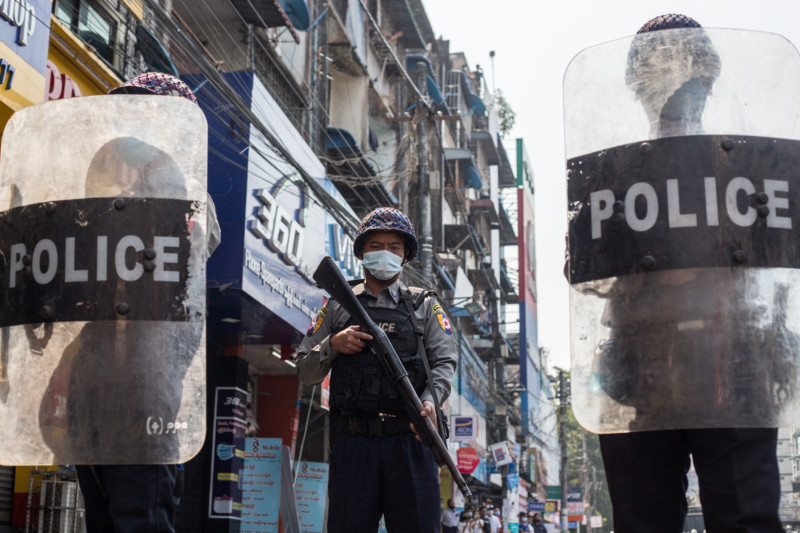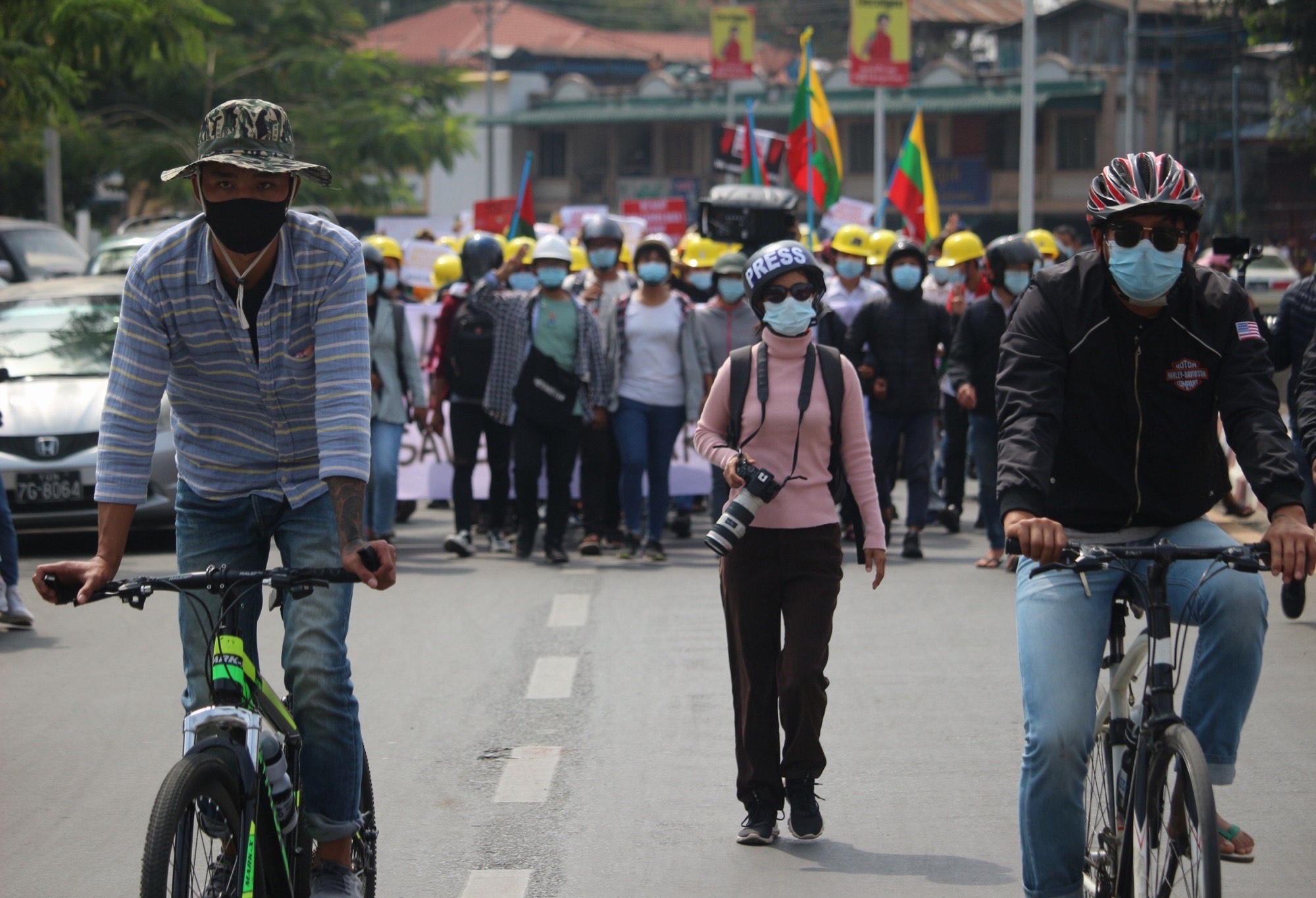From 1962 through 2011, a military junta ruled Myanmar. During that time, independent media reported in exile from neighboring countries or went undercover. The military imposed strict censorship, kept the price of sim cards prohibitively high, and isolated the southeast Asian country from the world.
When the democratically-elected government of Aung San Suu Kyi came to power in early 2016, it loosened some of its harshest restrictions on the press. But less than a year into its term, its relations with the press deteriorated. The government began suing and arresting journalists, and it blocked access to parts of the country where the military was committing widespread human rights abuses against the Rohingya and other ethnic minorities.
This year, on February 1, the military arrested Aung San Suu Kyi and more than forty other elected officials, and declared a state of emergency. By the end of the month, millions of protesters had demonstrated against the military regime. In response, authorities have fired live bullets, slingshots, rubber bullets, water cannons, teargas, and stun grenades into crowds. As of March 3, they’ve killed sixty-one people, according to Fortify Rights, and arrested more than 1,500 people, according to the Assistance Association for Political Prisoners.
Journalists reporting on the military’s crackdown on civilians have come under increasing threats from state forces––and from their supporters, who have beaten and intimidated journalists with escalating frequency and intensity. At least thirty-four journalists were arrested between February 14 and March 2, according to an AAPP tally; authorities beat at least five of them, according to CJR’s analysis of media reports. Some are still being held in jail, without charges.
“This could turn back to a situation like before 2010,” said Myint Kyaw, the former secretary of the Myanmar Press Council, a media adjudication body. The council, established in 2014 during the country’s political transition, had worked to intervene in press disputes and uphold media ethics. Now, at least fifteen of its twenty-six members have resigned. Myint Kyaw said the coup had rendered the council’s intervention on behalf of journalists impossible. “If we cannot protect them,” he said, “there is no use in staying in the MPC.”
In the first hours after the coup, Myanmar was under a near-total internet and mobile services blackout; as mass protests gained momentum, a second daylong internet shutdown ensued. Since February 15, the military has imposed nightly blackouts. The situation may worsen if a cybersecurity law passes: it would allow the military to shut down the internet, intercept data, and block certain websites.
On March 8, a Yangon-based news site, Myanmar Now, reported that soldiers and police raided its newsroom, taking computers, printers, and parts of the data server. The military junta also revoked its license to legally operate, along with four other prominent Yangon-based independent media outlets, according to a Reuters reporter.
CJR interviewed six journalists across six states and regions as protests against the military regime continue. They spoke about personal experiences with physical violence, fears of arrest, and the difficulties of reporting amid internet and mobile network shutdowns. Some were granted anonymity due to fear of reprisals from the authorities, while others requested to speak using their own names.
Shooting journalists using slingshots ‘has become their daily activity.’
On February 15, as a group of journalists filmed authorities’ violent response to demonstrations in the city of Mandalay, police officers and soldiers began to chase them. “They knew we were journalists and taunted and chased us while cursing at us,” said one photojournalist. “They said, ‘Come and take pictures of us, come!’ and insulted us.” The photojournalist escaped into a house. He climbed onto the roof and watched as a friend was caught and beaten.
“He was wearing a hat that said press, and he showed his staff identity card and shouted ‘I am a journalist! I am a journalist!’” the photojournalist told CJR. In response, the beating intensified.
“What we are seeing is that they are targeting people who wear press uniforms,” a photojournalist in the Kachin State capital said. On February 19, authorities cracked down on protesters in front of a teacher training college. The journalist said state forces used slingshots to shoot her and others covering the protest––despite shouting that they were members of the media. Since then, she said, shooting journalists using slingshots “has become their daily activity.”
J Paing, who heads the Yangon-based Myanmar Pressphoto Agency, said he is worried about continuing to give his staff t-shirts and hats that mark them as press, not only because of direct threats from the military, but also due to the potential of violence from regime supporters disguised as protesters. “There are invisible hands such as military supporters who go around holding knives, iron rods and wooden sticks,” he said. “They might stab us without anyone noticing because we are very visible with our press t-shirts and cameras.”

Police stand guard in Yangon on February 7. The photo was supplied by the authors.
Journalists across the country are hindered by police barricades that delay their movements, and a nationwide nightly curfew beginning at 8pm. Additionally, Mone Thant Mon, an editor with the Mon News Agency in the Mon State capital, said that the level of violence and arrests has made it increasingly difficult to find people willing to be interviewed.
One reporter in Kayah State, on Myanmar’s eastern border with Thailand, said that their office had been closed since the coup; they’re reporting minimally on the crisis. The least populous of Myanmar’s seven ethnic states, Kayah has only one local media outlet with around a dozen journalists. They’re afraid to travel to collect news, and worry they could be arrested from their homes. “The military already has information on all of us––where we live and where we work,” she said.
Mya Wun Yan, editor in chief of the Thanlwinthwaychinn Journal, said she has twice noticed people following her as she travels on her motorbike. Her journalists have been harassed, and have noticed what they suspect to be plain-clothes intelligence gatherers taking their photographs. The Journal has reduced its reporting capacity by around seventy percent, and several of its journalists are currently in hiding.
Kyaw Hsan Hlaing and Emily Fishbein are the authors. Kyaw Hsan Hlaing is a researcher and freelance journalist from Myanmar’s Rakhine State writing on peace, human rights and social justice. His work has appeared in Time Magazine, Foreign Policy, Al Jazeera and other media. You can follow him on Twitter @kyawhsanhlaing1. Emily Fishbein is a freelance journalist writing about human rights and social justice issues in Myanmar and among refugees in Malaysia. She especially seeks to amplify underrepresented voices and highlight the experiences of those affected by conflict. You can follow her on Twitter @EmilyFishbein11

